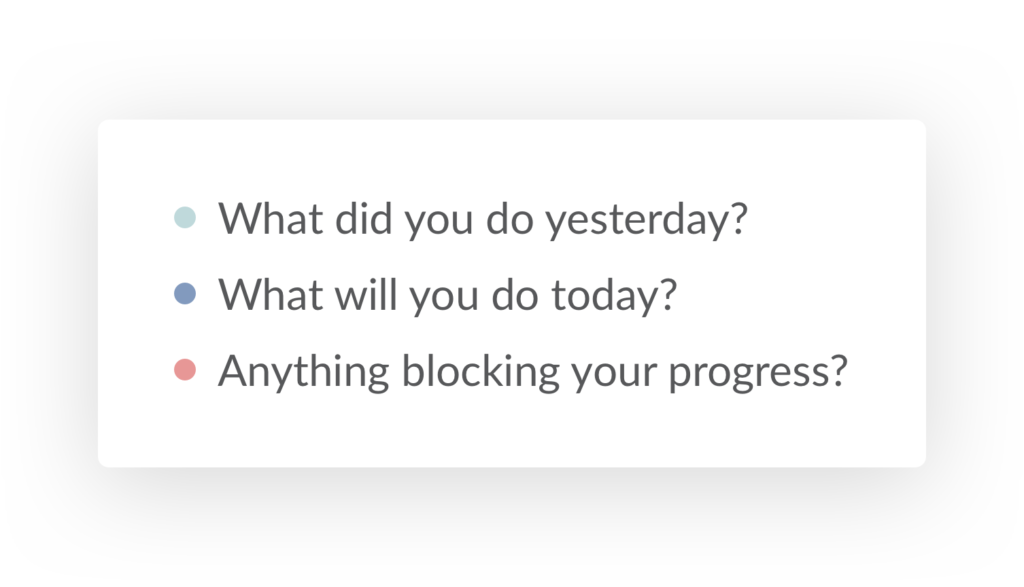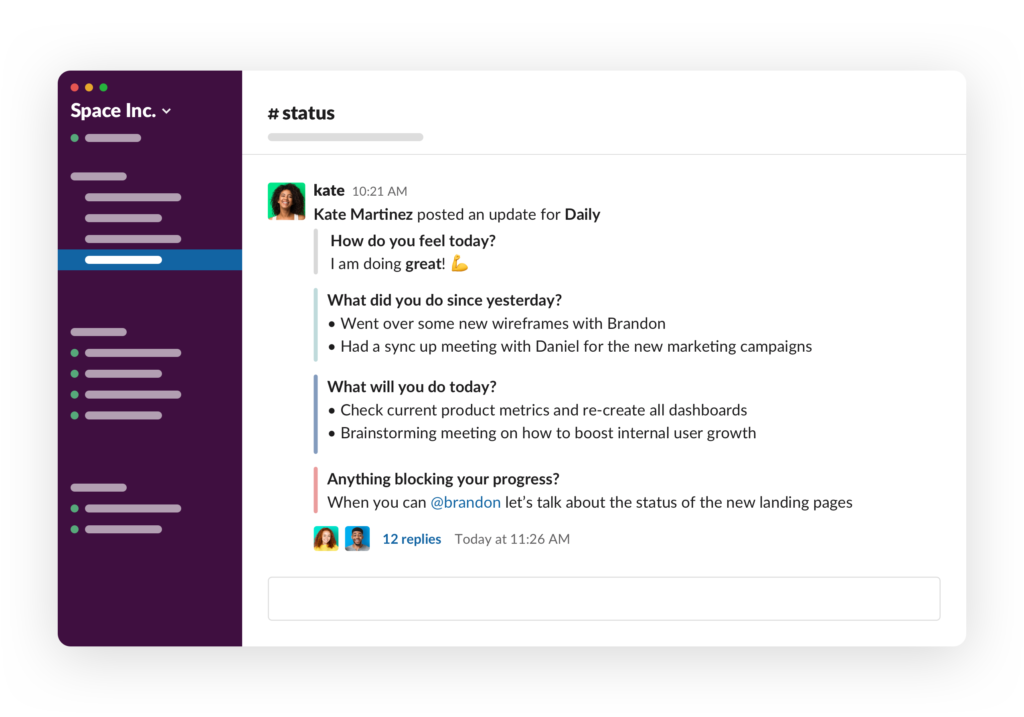The Concept of a Stand-up Meeting
Why does a smart soccer manager keep his players on their feet when a game is about to go into extra time?
Because this helps his players to stay in the moment, stay sharp and focused on what’s happening, what’s about to happen, and anything that could stop him from getting the result he wants. Put simply, he does that to win.
Describing the basic concept of a Stand-up Meeting could be as simple as that. To keep a workplace meeting short and efficient you all need is to stand up. You know, physically stand up and not just when it’s your turn to talk. Also, don’t stand up for more than a quarter of an hour.
Daily Standup, or sometimes called Daily Scrum, is a team-meeting which ideally takes place at the same time each morning because that’s when the minds are clear, ideas are fresh and team energy is at its highest.
During a daily stand up meeting, team members need to answer three key questions:
- What did you achieve yesterday?
- What do you hope to achieve today?
- Is there anything stopping you from hitting your targets for the day?
The purpose of these specific questions is for all the team members to make commitments to each other and to keep everyone focused on sprint goals. Besides, the aim is to repeatedly create plans for the next sprints within a project, not to create new long-term plans.

When and Where the Daily Scrum is held?
Ideally, the Daily Scrum is held at the same time and the same place every morning because consistency is essential. Besides creating a sense of familiarity, regularity, and continuity amongst the participants, in which they’ll undoubtedly feel more comfortable and more likely to contribute appropriately, it also promotes optimum attendance levels.
Barring extreme external factors, nobody really has much of an excuse not to be there. The venue should be secluded to avoid unnecessary interruptions, free of seating (with the notable exception of accommodating members with physical difficulties) to keep everyone on their feet, and comprehensively equipped with relevant project management tools, such as a Kanban Board, providing visual results and targets in chronological order.
Who Uses a Daily Scrum?
In a nutshell, any team can use Daily Scrums to their advantage.
Traditionally a term used in development methodologies, the Daily Scrum is in fact a very relevant communication tool for a wide range of organizations.
It applies to any company running a new short-term project and also, arguably, compliments the ongoing operation of many different operations and businesses both new and established. Think again about the smart soccer manager analogy and the value of those three key questions above. Not just his defense, midfield, and attack can contribute to the flow of information but also his coaching staff and himself.
Each group is doing something different and is expecting to face further difficulties but the final result for the team is what really matters. That flow of information around that whole team can provide ideas on the optimum way forward.
Who Should Participate In Daily Stand-Ups and How?
Ideally, all team members should participate in a Daily Scrum.
In case one or two team members are absent (in the soccer team scenario; one player has been injured and one sent off), the team meeting still goes ahead because, ultimately, the team and the final result are more important than one or two individual players.
Because Scrum is a daily opportunity for communication between everyone, each team member should be allowed to contribute.
Therefore, all individuals are active in the transfer of information within the project. Namely, they report back on what has been done since the last meeting (the morning before), what they expect to have achieved by the next meeting, and whether they have any foreseeable problems which could impede their aims for the day.

The Product Owner and Scrum Master Duties in the Daily Scrum
Besides team players, two other people participate in a daily meeting: the Product Owner and the Scrum Master. These are described as Agile roles.
The Product Owner is the main project stakeholder who has a vision of where the company goes and what the development team should work on.
The Scrum Master is an agile coach who makes sure that all agile practices, including Daily Standups, are properly conducted. For example, Scrum Master notify team members if Daily Scrum is taking too long or when discussions trail off.
Although it’s a team game, the Scrum Master may in fact be considered to be the most important player and hence needs the right character and usually certified training. His role is considered to be the catalyst in the Daily Scrum.
Regulating meetings, solving problems highlighted, or delegating responsibilities to internal or external departments is all part of the job. He or she doesn’t have to be within the management hierarchy but someone who has the natural traits or trained abilities for this critical position.
The Scrum Master is also “Mr. Motivator”, you know the one in the team who not only coordinates but also keeps spirits up when times get hard. Organizations sometimes decide to exclude him from the game claiming that a sole person can combine the two roles, but this is one of the most common mistakes that can later sabotage your Agile & Scrum results.
It’s not just the team that can be there. A complete Scrum can, and ideally should, include interested parties from other departments within an organization.
Although these people are observers rather than participants, it is often critical where, for example, an advertising department is fully up to date as to where in a production cycle a new product is. There are usually direct timescale effects on them.
Note: Try Keeping Your Phones Off
For the best results everyone needs to have their cell phone turned off just once a day for the short 15 minutes of the Daily Scrum. This is a face-to-face communication process and therefore demands direct human involvement and interaction.
What are the Benefits of the Daily Scrum?
People get together
The key benefit of Scrum is that people from different departments within the same company, working on the same project with the same team goal actually get together once a day in a semi-formal/formal environment. It sounds simple but really, does this happen in many workplaces or organizations?
Efficient use of time
It’s also the Scrum’s time factor and the culture of a stand-up meeting. Being on your feet for 15 minutes should mean you are physically and mentally sharp, focused, and involved. The latter, involvement, and involvement on a regular daily basis is another major positive. It could be argued very forcibly that a 15 minute stand up meeting once a day is far more productive in any operation than a one and a half-hour sit-down meeting once a week. And, how many organizations still use the latter technique, usually late on a Friday afternoon when minds are winding down and are thinking of the weekend ahead?
Increased flexibility
Infrequently changing projects the Scrum has clear advantages since it re-evaluates the fluidity of any particular project. Let’s go back to that soccer match again. The score is 1-1, the 90 minutes have finished and there are 30 minutes extra time to go. A couple of hours ago your team had a sure-fire game plan to win but many variables have now altered that. You’ve lost two key players from your team and your opponents are not playing the system you had originally envisaged. If things stay like this, you’re probably going to lose. You need to adapt and you need input from those directly involved to achieve that. Hence, it particularly suits projects that are rapidly and constantly changing.
Creates a working momentum
The regularity of the Scrum may seem negative in nature but, in fact, repetition is a basic component of agile processes. It is seen positively since small problems ultimately lead to big problems.
Boosted team collaboration
The Daily Stand-up meeting is not the be-all and end-all. Since the level of detail discussed needs to be minimal, as it’s not relevant to every team member, the Scrum leads to follow-up meetings between team members involved in particular segments of a project. This post-Scrum collaboration amongst self-managed teams cooperating and sharing information is again a fundamental of agile processes.
Equal input from all team members
One person reports at a time in an organized manner controlled by the Scrum Master. A completely different approach than in a traditional meeting where, undoubtedly, the flamboyant characters, Cristiano Ronaldo if we were back at the soccer match, tend to hold center stage.
Can be presented visually
Not only is it a verbal meeting but also a visual one. The task board giving specific updates adds optical information and stimuli to team members.
Easy to organize
.Last but not least, organizing a Daily Scrum is not really that difficult. Simplicity almost always leads to better results. Focus on running more effective stand-ups and keep away from the waterfall trap.
How to Make The Most Out Of Your Daily Standups:
Daily Standup meetings can boost your team’s productivity and collaboration, but the key to success is consistency.
Setting these meetings up, gathering responses, and making sure Daily Scrum is conducted properly every day can take a lot of time.
Fortunately, the right tools can do that for you. Geekbot automatically sends stand up questions to your team members directly in Slack and then stores all the responses in a specific channel.

The best part? Geekbot is asynchronous, which means that your colleagues can send their responses whenever they can without being distracted from work. In addition to that Geekbot analyses responses with NLP-algorithms, letting you track the well-being and happiness of your team in real-time:
Use Geekbot to automate standups, surveys, retrospectives, and daily reports. Best part? Free 30-days no strings attached trial.
What are the Drawbacks of the Daily Scrum?
In theory, Scrum is a powerful organizational tool because of the points stated above. But, as with everything, it could be argued that there are negatives.
Need to monitor team engagement.
We are all human and we all have different human traits. In time, the regularity of the stand-up meeting can lead some team members to a sense of indifference and boredom. Reporting so regularly on what you’ve achieved and what you hope to achieve may become an unwanted chore. Similarly, it may lead to demotivation issues amongst some players. Those who for whatever reason cannot consistently reach their daily targets may begin to feel inferior and isolated from the rest of the team. Therefore, it is really important to identify why your daily scrum might be boring and refocus immediately on the purpose of the meeting.
Solution: check out these 7 fun standup meeting ideas to keep your daily standup meetings fresh and engaging.
Some people might be louder than others.
There are practical problems too. Is the Scrum Master powerful enough to control the wayward participants who are talking, maybe not listening and concentrating, or just feeling that little bit too comfortable? Are all the staff confident enough to speak in front of their peers? Do some team members feel that it’s not a positive project management tool but a daily review of their contribution to the organization? And, what about those late arrivals? Do you go over everything again because someone inadvertently missed the start time? Scrum Mastering is a critical element but not too many personalities can really achieve that.
Solution: use scrum tools such as Geekbot that let your team members answer the questions in Slack asynchronously without having to wait for others.
A lot depends on the Product Owner skills and attitude.
The Product Owner could be a problem too. He or she ought to be encouraged to be at the meeting, but do they get involved when they should theoretically be a passive participant? Although, it should be noted that different agile method theorists differ on this subject, namely on the role of the Product Owner. But, perhaps, more importantly, do some team members end up feeling subservient because the “boss is there”?
Solution: check out our Scrum Ceremonies and Artifacts: What Wasn’t in the Scrum Guide to see why it’s important for Scrum teams to stick to their roles and guidelines.
Follow-up meetings still need to be effective.
Another drawback is how well sub-meetings afterward are conducted and whether they achieve quality results. As well as the Scrum may have gone, you may not have such cooperation and positive outcomes from these follow-up discussions.
Solution: the problem of too many meetings at the workplace is more common than you might think, but with time Daily Scrum teams learn to organize themselves more effectively.
When unmoderated can become a status meeting
. Maybe worst of all, in some literary texts, the Daily Scrum is referred to as “Roll Call”, namely the roll call that kids had at High School each morning particularly back in the 1970s. In essence, this undoubtedly creates a feeling of something outdated, childish, and almost terrorizing. Although we’re talking about the disadvantages rather than solutions to the problems, it’s worth mentioning that online Scrums may be a cure to these phenomena.
Solution: watch out for faulty mindsets when it comes to applying Scrum in teams in Am I Agile? 5 Mindsets That Will Ruin Your First Sprint
Time to Go to Work
So, the team members have reported on their achievements, stated their aims, highlighted potential problems, and the Scrum master has done his bit. It’s all taken about the same time as a break in a soccer match.
It’s got its good points, it’s got its bad, but the Scrum is over and everyone should be far better equipped. Let’s go now and win this game!
Want to take your standup meetings to the next level?
With Geekbot you can eliminate dozens of unnecessary meetings and bring distributed remote teams closer than ever. See for yourself how Geekbot can help you make the most out of your agile meetings with our free 30-day trial.
Frequently asked questions
What is a daily standup meeting in Scrum?
Daily standup meeting is one of the pivotal ceremonies of Scrum framework. Daily standups are regular short daily meetings usually within 15 minutes where team members share their current progress, planned actions, and any roadblocks that affect their work progress. Daily standups usually run with team members standing up, however this is not necessary, especially in teams that operate remotely.
What are the 3 questions asked at a Scrum standup meeting?
he three main standup questions are:
1. What did you do yesterday?
2. What are you going to do today?
3. Are there any roadblocks in your way?
What is the purpose of Scrum standup?
The purpose of Scrum standup is for Scrum team members to share current progress, foster collaboration, and identify any roadblocks that can prevent Scrum team from successfully completing their Sprint tasks. It’s imperative to remember that standup meetings are not status meetings and should be treated as such by managers and team members.



